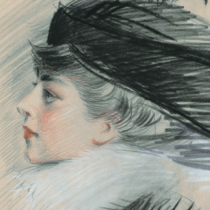Magazine

Writing Belle
The now-famous librarian to J.P. Morgan wrote often to the director of the U-M Library. Their correspondence reveals mutual respect, admiration—and benefit.
By Lara Zielin
In 1905, Belle da Costa Greene was hired by the indomitable banker and financier J. P. Morgan to curate a collection of rare manuscripts, books, and artwork for his newly built Pierpont Morgan Library in Manhattan, New York.
Greene’s literary and business savvy helped Morgan create a world-class collection. She was unquestionably brilliant, while also defying the racism of the time by passing as white. The story of her life—and her painful secret—is the subject of a recent bestselling book, The Personal Librarian (Berkley, 2021), co-written by Marie Benedict and Victoria Christopher Murray.
Greene’s now-famous story also extends to papers at the Bentley Historical Library through her correspondence with the Director of the University of Michigan Library, William Warner Bishop.
Bishop became library director in 1915 and quickly went to work growing U-M’s collection of books and training staff on its organization and use. Bishop was key in establishing a department of library science at U-M to train individuals in bibliographical and other library-related skills.
Greene tapped on Bishop’s expertise in 1927, when she hoped to send her assistant, Virginia White, to interview him regarding “several points concerning library matters,” specifically, advice on “certain cataloging problems which have come up in our work.”
She also asked Bishop, in 1929, to weigh in on “the question of photostating [an early form of photocopying] a complete manuscript or book for the use of individual students. . . . I trust that you will forgive me for imposing upon your kindness to this extent?”
The relationship was mutually beneficial as Bishop leaned on Greene for access to rare materials for researchers. In 1928, he asked Greene if graduate student Alice K. Hall could get access to limited works by the poet John Keats. Bishop also helped negotiate multiple “photostats” of manuscripts for English Professor Roy W. Cowden.
The relationship flourished and, on several occasions, Greene invited Bishop to New York. “I do hope that the next time you are in New York, you will write the name of the Morgan Library all over your calendar,” she wrote to him in 1934. Later that year, she invited him to a dinner hosted by the Friends of the Princeton Library (Bishop had been the head cataloger at Princeton for two years). “It will mean a great deal to all of us, as you can well understand, if you will lend us your personal charm and your outstanding reputation for that evening,” she wrote.
Bishop retired in 1941; Greene in 1948. At the time he retired, Bishop had grown the total number of volumes in U-M’s collection from just over 350,00 to more than one million, several of the rarest being copies from the Morgan collection. When she retired, the New York Times praised Greene for having “transformed a rich man’s casually built collection into one of which ranks with the greatest in the world.”
(Lead image: A pastel portrait of Belle da Costa Greene, circa 1913, by Paul César Helleu, Creative Commons.)
